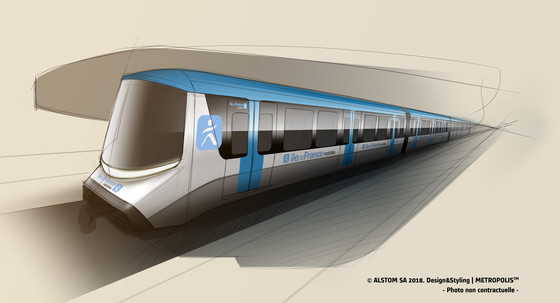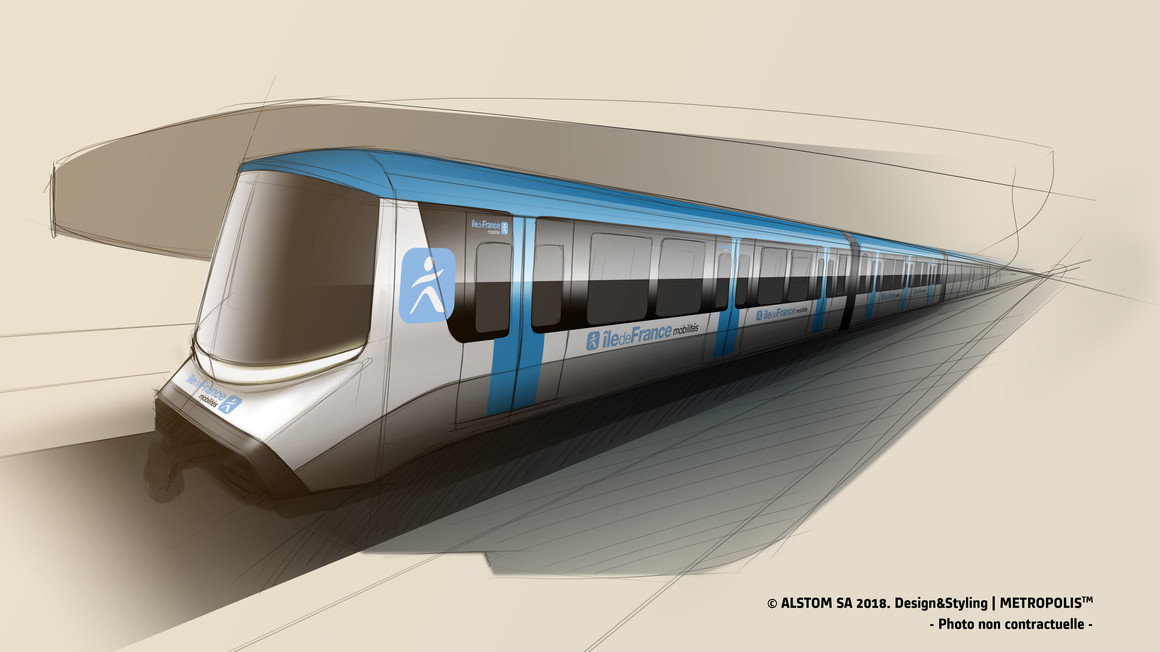
Société du Grand Paris, in agreement with Île-de-France Mobilités, selects Alstom to supply trains for lines 15, 16 and 17 of the Grand Paris Express
Société du Grand Paris, in agreement with Île-de-France Mobilités, selects Alstom to supply trains for lines 15, 16 and 17 of the Grand Paris Express

Investor relations
Cyril Guerin
Send an emailGuillaume Gauville
Send an emailEstelle Maturell Andino
Send an emailJalal Dahmane
Send an email20 September 2018 Following a negotiated procedure, preceded by a tender launched in 2014, Société du Grand Paris, in agreement with Île-de-France Mobilités, has selected the rail manufacturer Alstom to develop and supply the trains for metro lines 15, 16 and 17 of the Grand Paris Express.
The contract, which is fully financed by Île-de-France Mobilités, is worth a total amount of up to 1.3 billion Euros and covers the development and supply of a maximum of 1,000 cars (183 trains), to be deployed in two versions of different train lengths, 3 and 6 cars.
On 11 July 2018, the Board of Directors of Île-de-France Mobilités approved a first tranche of 680 million euros to cover the necessary expenses to acquire the first 53 trains of the Grand Paris Express. The firm part of this contract awarded to Alstom covers the delivery of 150 cars (25 trains of 6 cars each) for a total amount of over 280 million Euros[1].
These new, high-capacity, steel-wheeled metros will be able to circulate at speeds of up to 110 km/h in automatic driverless mode, taking the form of six-car trains on line 15 and three-car trains on lines 16 and 17.
The first trains will leave the factory from 2022 onwards and initial entry into commercial service is scheduled for 2024.
Île-de-France Mobilités will be making these trains available to future operators, thus giving them access to new-generation material that benefits from the latest technologies and offers a high level of performance. The travel experience will combine comfort and speed.
Valérie Pécresse, President of the Île-de-France Region and of Île de France Mobilités, says: "With air conditioning, video protection, USB plugs and efficient tools for providing onboard information, the new trains for Île-de-France Mobilités will provide users of Île de France’s new metro lines with high levels of comfort and safety, something I insist on for all orders of new material, metros as well as trains, RERs, buses and trams. These metros will also symbolise the modernity and dynamism of Europe’s leading economic region.”
“The acquisition of the trains destined to run on the lines of the Grand Paris Express represents the accomplishment of one more step in implementing the new metro. It follows the award of a series of important civil engineering contracts and paves the way for the first contracts for the systems that will equip these infrastructures. This is good news for companies who are seeing their order books fill up, as well as for the residents of Île de France, for whom the Grand Paris Express is taking more shape every day.”
Thierry Dallard, President of the Board of Directors of Société du Grand Paris
”We are very proud of the renewed confidence of Île-de-France Mobilités and the decision of Société du Grand Paris to award this new contract to us. We are also particularly pleased to contribute, through this new project, to the government's determination to double the Paris metro network over the next 15 years,” says Henri Poupart-Lafarge, Chairman & CEO of Alstom.
A new experience in public transport travel
The new metros for lines 15, 16 and 17 are open throughout the entire length of the train, providing passengers with a sociable, roomy, comfortable space. Thanks to the 3 large doors on each side, they increase fluidity in the exits and entrances, as well as facilitating passenger movement during travel. The equipment has been designed for high levels of comfort, notably thanks to the air conditioning, lighting and seats. It will also offer connectivity to passengers with USB charging points for mobile phones. Finally, the end of the train is structured to provide a panoramic opening with a wide windscreen.
Based on the solutions of Alstom’s Metropolis range and further improved by feedback from its customers, the new metros for lines 15, 16 and 17 will guarantee the highest levels of availability, reliability and security. Each train will be able to transport up to 500 passengers in its three-car version (54 metres), and up to 1,000 passengers in its six-car version (108 metres). Particular attention has been given to optimising maintenance. The onboard diagnostic system will provide information on the condition of the train equipment and give maintenance personnel an overview of the fleet’s condition, making it easier to plan corrective maintenance tasks between commercial services. Alstom has also extended the maintenance sequence of the new metros, permitting significant cost reductions throughout the lifecycle of the trains.
Numerous innovations guarantee the new material’s environmental performance, which is an undeniable asset for operation. Traction and auxiliary converters will benefit from the very latest technology developed by Alstom, guaranteeing optimised energy consumption. Special attention has been paid to noise emissions, vibrations and atmospheric emissions. Brake particle emissions will be minimised by electric braking right up to a very low speed, limiting brake disc use. Furthermore, the recovery of braking energy will play a role in charging the batteries or supplying power to the general electricity network. Last but not least, the train has a recyclability rate of more than 96% and, in line with current European standards, a recovery rate of over 98%.
In total, 350 Alstom employees in France, including 150 experienced engineers, will be working on this vitally important project to ensure its successful implementation. More than 1150 jobs will be secured in France for the French rail sector as a result of the project. Alstom, a solidarity-based enterprise, will also reserve significant volumes of work on its French sites in terms of manpower hours planned for this contract for people experiencing particular social or professional difficulties.
The trains will be designed and manufactured by six of Alstom’s sites in France. The site of Valenciennes Petite-Forêt will be in charge of project management, studies, development, production, assembly and validation. Five other Alstom sites in France will develop and produce the components: Le Creusot for the bogies, Ornans for the engines, Tarbes for the traction systems, Villeurbanne for the on-board electronics and the remote maintenance system and Saint Ouen for the design.
[1] This contract will be booked at the latest in Q3 of the current fiscal year.